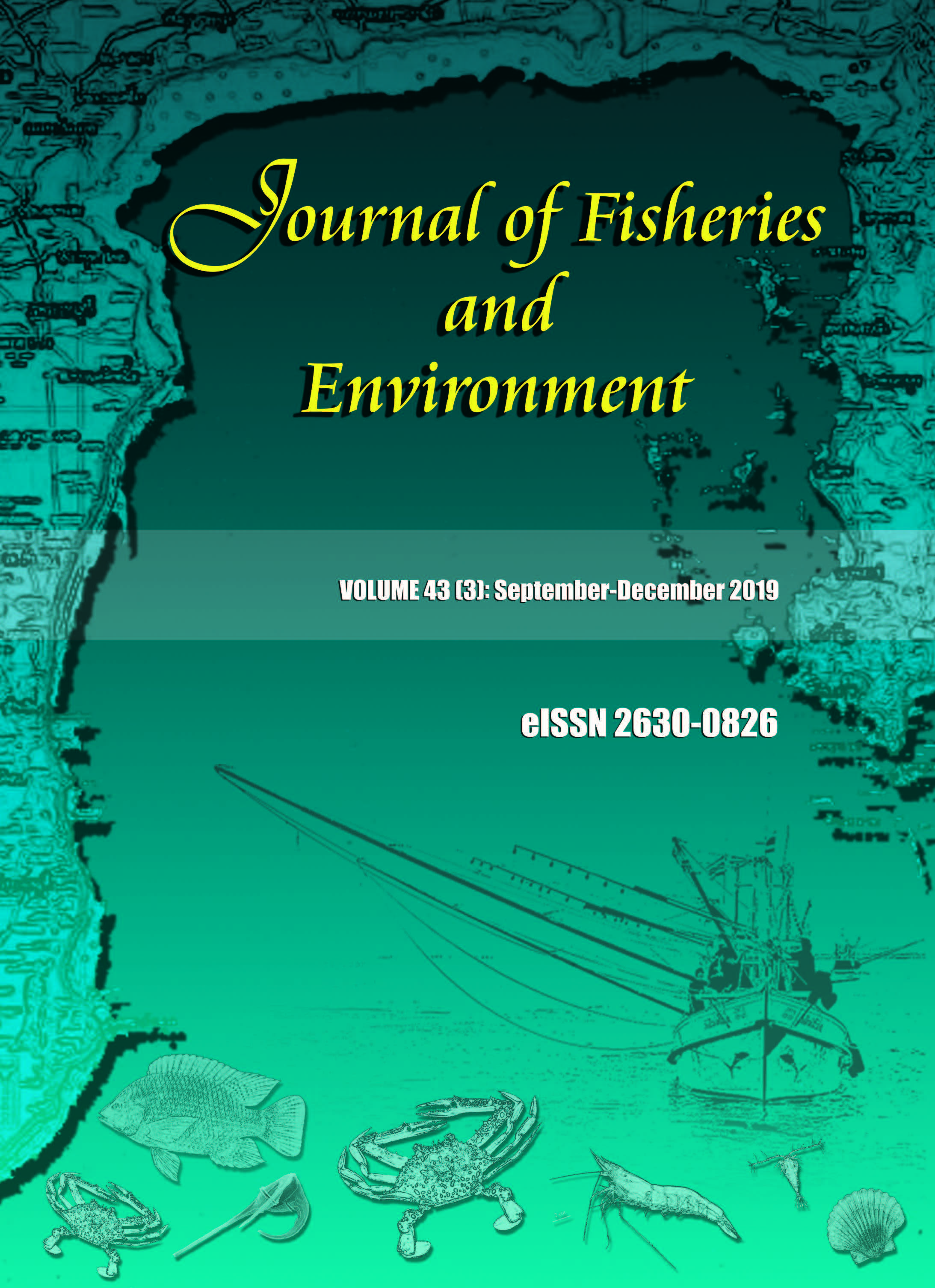Potential Fucoxanthin Production from a Marine Diatom
Main Article Content
Abstract
Potential production of fucoxanthin from a marine diatom (Chaetoceros sp.) isolated from the Pranburi River mouth, Gulf of Thailand was investigated. Results showed that Chaetoceros sp. had a high growth rate. Specific growth rate (µ) was approximately 0.59 day-1, while doubling time was approximately 1.18 days under irradiance of 70 µmol photons·m-2·s-1. Specific growth rate increased with increasing irradiance (µ=1.04 at 140 µmol photons·m-2·s-1). The doubling time of this Chaetoceros sp. was only 0.67 days under irradiance of 140 µmol photons·m-2·s-1. Results from HPLC analysis demonstrated that Chaetoceros sp. gave maximum fucoxanthin production at 7.68 mg·g-1 dry weight or 5.87 pg·cell-1 under irradiance of 140 µmol photons·m-2·s-1. Findings implied that the selected Chaetoceros sp. showed higher potential for commercial-scale fucoxanthin production than other seaweeds and diatoms.
Article Details
References
2. Andersen, R.A. 2005. Algal culturing techniques. Elsevier Academic Press, Burlington, United States. 578 pp.
3. Bertrand, M. 2010. Carotenoid biosynthesis in diatoms. Photosynthesis Research 106: 89-
102.
4. Cogdell, R.J. and H.A. Frank. 1987. How carotenoids function in photosynthetic bacteria. Biochimica et Biophysica Acta (BBA)-Reviews on Bioenergetics 895: 63-79.
5. Creswell, L. 2010. Phytoplankton culture for aquaculture feed. SRAC Publication No. 5004. National Institute of Food and Agriculture, USA. 12 pp.
6. De La Rocha, C. 2004. Recovery of Thalassiosira weissflogii from nitrogen and silicon starvation. Limnology Oceanography 49: 245-255.
7. Demmig-Adams, B. 1990. Carotenoids and photoprotection in plants: a role for the xanthophyll zeaxanthin. Biochimica et Biophysica Acta (BBA)-Bioenergetics 1020: 1-24.
8. Fujiki, T. and S. Taguchi. 2001. Relationship between light absorption and the xanthophylls-cycle pigments in marine diatoms. Plankton Biology & Ecology 48: 96-103.
9. Gagnon, R., M. Levasseur, A.M. Weise, J. Fauchot, P.G.C. Campbell and B. Vigneault. 2005. Growth stimulation of Alexandrium tamarense (Dinophyceae) by humic substances from the Manicouagan River (Eastern Canada). Journal of Phycology 41: 489-497.
10. Guillard, R.R.L. and M.S. Sieracki, 2005. Counting cells in cultures with the light microscope. In: Algal culturing techniques (ed. R.A. Anderson), pp. 239-252. Elsevier, New York, United States.
11. Hager, A. 1975. Die reversiblen, lichtabhangigen Xanthophyll-umwandlungen im Chloroplasten. Berichte der Deutschen Botanischen Gesellschaft 88: 27-44.
12. Hosokawa, M., M. Kudo, H. Maeda, H. Kohno, T. Tanaka and K. Miyashita. 2004. Fucoxanthin induces apoptosis and enhances the antiproliferative effect of the PPARgamma ligand, troglitazone, on colon cancer cells. Biochimica et Biophysica Acta (BBA)-General Subjects 1675: 113-119.
13. Jaswir, I., D. Noviendri, H.M. Salleh and K. Miyashita. 2012. Fucoxanthin extractions of brown seaweeds and analysis of their lipid fraction in methanol. Food Science and Technology Research 18: 251-257.
14. Kim, S.M., Y.J. Jung, O.N. Kwon, K.H. Cha, B.H. Um, D. Chung and C.H. Pan. 2012. A potential commercial source of fucoxanthin extracted from the microalga Phaeodactylum tricornutum. Applied Biochemistry and Biotechnology 166: 1843-1855.
16. Kooistra, W.H.C.F., M. De Stefano, D.G. Mann and K. Medlin. 2003. The phylogeny of the diatoms. Silicon Biomineralization 33: 59-97.
17. Lichtenthaler, H.K. 2007. Biosynthesis, accumulation and emission of carotenoids, alpha-tocopherol, plastoquinone, and isoprene in leaves under high photosynthetic irradiance. Photosynthesis Research 92: 163-179.
18. Liu, C.L., A.R. Place and R. Jagus. 2017. Use of antibiotics for maintenance of axenic cultures of Amphidinium carterac for the analysis of translation. Marine Drugs 15: 1-14.
19. Lohr, M. and C. Wilhelm. 2001. Xanthophyll synthesis in diatoms: Quantifications of putative intermediate and comparison of pigment conversion kinetics with rate constants derive form a model. Planta 212: 382-391.
20. Lorenz, R.T. and G.R. Cysewski. 2000. Commercial potential for Haematococcus microalgae as a natural source of astaxanthin. Trends in Biotechnology 18: 160-167.
21. Medlin, L.K. and I. Kaszmarska. 2004. Evolution of diatoms, V: morphological and cytological support for the major clades and a taxonomic revision. Phycologia 43: 245-270.
22. Murakami, C., M. Takemura, Y. Sugiyama, S. Kamisuki, H. Asahara, M. Kawasaki, T. Ishidoh, S. Linn, S. Yoshida and F. Sugawara. 2002. Vitamin A-related compounds, all-trans retinal and retinoic acids, selectively inhibit activities of mammalian replicative DNA polymerases. Biochimica et Biophysica Acta (BBA)-Gene Structure and Expression 1574: 85-92.
23. Parsons, T.R., Y. Maita and C.M. Lalli. 1984. A manual of chemical and biological methods for sea water analysis. Reprinted 1992. Pergamon press, Oxford, United Kingdom. 173 pp.
24. Richmond, A.D., M. Blanc, B.A. Emery, R.H. Wand, B.G. Fejer, R.F. Woodman, S. Ganguly, P. Amayenc, R.A. Behnke, C. Calderon and J.V. Evans. 1980. An empirical model of quiet-day ionospheric electric fields at middle and low latitudes. Journal of Geophysical Research Space Physics 85: 4658-4664.
25. Ritchie, R.J. 2006. Consistent sets of spectrophotometric chlorophyll equations for acetone, methanol and ethanol solvents. Photosynthesis Research 89: 27-41.
26. Stauber, J.L. and S.W. Jeffrey. 1988. Photosynthetic pigments in fifty-one species of marine diatoms. Journal of Phycology 24: 158-172.
27. Strzepek, R.F. and N.M. Price. 2000. Influence of irradiance and temperature on the iron content of the marine diatom Thalassiosira weissflogii (Bacillariophyceae). Marine Ecology Progress Series 206: 107-117.
28. Sunesen, I., D.U. Hernandez-Becerril and E.A. Sar. 2008. Marine diatoms from Buenos Aires coastal waters (Argentina) V. Species of the genus Chaetoceros. Reviata de Biologia Marina y Oceanografia 43: 303-326.
29. Van Leeuwe, M.A., L.A. Villerius, J. Roggeveld, R.J.W. Visser and J. Stefels. 2006. An optimized method for automated analysis of algal pigments by HPLC. Marine Chemistry 102: 267-275.
30. Vincent, W.F., P.J. Neale and P.J. Richerson. 1984. Photoinhibition: algal responses to bright light during diel stratification and mixing in a tropical alpine lake. Journal of Phycology 20: 201-211.
31. Watanabe, M.M., F. Kasai, and R. Sudo. 1988. The microbial culture collection. In: NIES-collection list of strains. Microalgae and protozoa, 2nd ed. (eds. M.M. Watanabe, F. Kasai, and R. Sudo), pp. 130-147. The National Institute for Environmental Studies, Tsukuba.
32. Xia, S., K. Wang, L. Wan, A. Li, Q. Hu and C. Zhang. 2013. Production, characterization, and antioxidant activity of fucoxanthin from the marine diatom Odontella aurita. Marine Drugs 11: 2667-2681.


